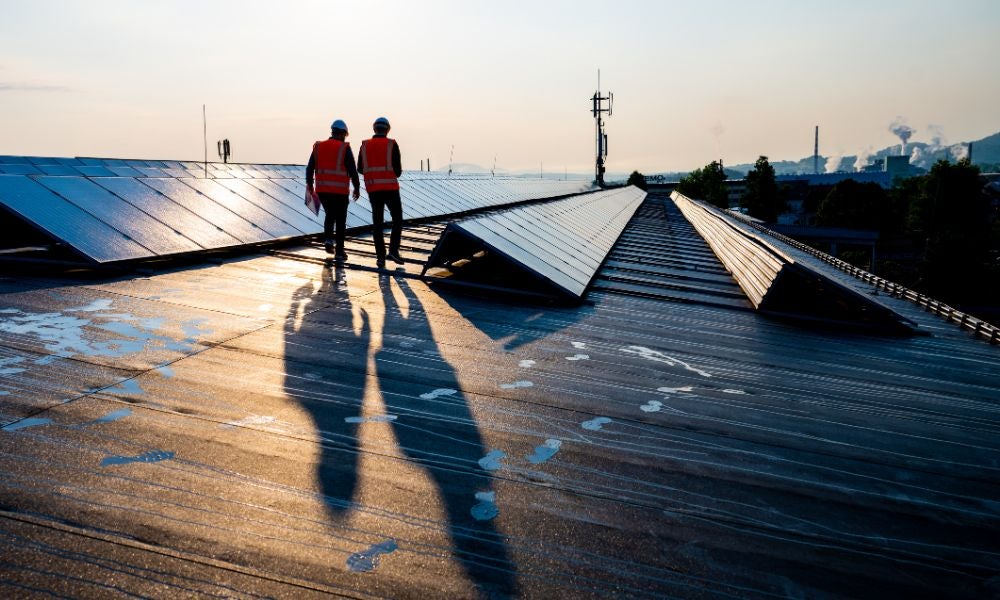How Australia can play in – and win – the energy transition
Australia has a unique opportunity to become a renewable energy superpower, but only if it can build the right transition ecosystem through strategic partnerships
Australia has a natural comparative advantage and an “incredible opportunity” to be a world leader in the energy transition, according to PwC Partner Subhodeep Ghosh. To turn that into a competitive advantage, he said four key factors need to align – and that partnerships will be essential.
These factors – political, economic, social and technological – are important individually, but their collective deployment will also be required for Australia to be able to tap into its unique energy opportunities, said Mr Ghosh, a senior partner at Strategy&, part of the PwC network. Speaking at the recent UNSW Forum on Climate Finance, Decarbonisation & Green Industry Development, which was organised by UNSW Professor of Economics Fariborz Moshirian through the Institute of Global Finance, Mr Ghosh noted that bipartisan political support is also important, although less certain, and that economies must work together to set and meet necessary targets.
“We’ve got some really good advantages,” he said, pointing to Australia’s access to wind, solar and other resources. “But at the same time, how do we maintain that advantage going down that cost curve, not just from a generation perspective but from the oil flight perspective as well?”

Collective response needed
However, these economic questions are still just one aspect of the multifaceted challenge, which Mr Ghosh said highlights the need for all four factors to line up collectively to enable a global energy transition within the ever-dwindling time available. “Even if we get the politics and the economics right, the social impact of this energy transition is very important,” he said. “We’re still 50% dependent on coal. A lot of livelihoods depend on coal, and we have to manage that social impact really, really well.
“At the same time, Australia has these real advantages, such as a highly educated workforce. We are clearly thinking in that direction and building the capability that’s going to be required in the workforce of the future across all fields – across science and technology, but also executive management. We need a lot of that capability-building in executive teams at big companies in industry as well.”
Meanwhile, research and development are required to support the technological elements and advancements necessary to transition the world’s energy systems. “But how do you deploy this technology at scale and in an economic way that makes sense to investors?” Moreover, the technology itself is multifaceted, with infrastructure, grid, operation, and other components, all of which must be developed and supported.
Read more: Why Australia holds the roadmap to lead the energy transition
“The key message is that Australia already has some advantages in those four factors, but there are also challenges in those four areas that need to be considered carefully and made progress on,” he said. “All of them are individually important, but you must also consider them collectively; if you don’t, if you miss out on one or the other, then you’re probably not going to be able to fully tap into that opportunity. There is a lot of orchestration required across the different aspects of this energy transition.”
Roadmap to opportunity
Translating these concepts into a realistic transition roadmap is part of the challenge; to simplify the message, Mr Ghosh said it’s helpful to think about a few required steps. First is the grid firming and upgrade needed in the transmission and distribution domain.
He explained that renewables are inherently more volatile, distributed and intermittent than fossil fuels. “Our grids are designed around some centralised coal-fired power plants,” he said. “We have to recognise that the grid needs modernisation and upgrade, and that requires technology, and that determines how pricing is done, et cetera. There are many things that need to happen as we transition to renewables on the grid side.”

Another consideration is baseload generation, which must be improved alongside the grid. Finally, Mr Gosh pointed to what he considers Australia's real opportunity: to become a “renewable energy superpower, where Australia could become an exporter of this energy to other markets” by leveraging its natural comparative advantage,” he said.
“We would serve our own markets but then also have an opportunity to serve other markets where there is demand but where we may have a better advantage on those four factors. Obviously, that’s a bit further on the horizon – we’ve got to figure it out here, and then we can start exporting some of our renewable energy outside as well.”
Momentum and risks
While half of Australia’s power generation still depends on coal, Mr Ghosh noted that this represents an inflection point, as coal usage continues to decline and renewables pick up more of the difference. The transition will thus require significantly more electricity generation, with global consumption expected to nearly double by 2050. Grid-scale wind and solar will need to increase sevenfold, while distributed photovoltaic solar must increase fourfold. And then there’s storage and grid modernisation.
However, these trajectories show “there’s momentum happening around wind, solar and battery, and that we’re building things”, he said. “But I do think we have an opportunity to not just play in this market but win in this market.”
Read more: Can accounting fix global climate disclosure challenges?
There are risks inherent in the transition, including issues that may prompt some investors and companies to resist a deeper commitment to transition. “There are things around land access, which can be a challenge to overcome; even projects that have been approved, where these things keep coming up throughout their development,” Mr Ghosh said.
He also acknowledged that critical work still needs to be done on infrastructure, which will require greater investment and finance commitments; for example, about 10,000 kilometres of new infrastructure is currently needed for renewable connections in Australia. “We are currently limited by the physical capacity.”
‘This has to work for everyone’
An overarching goal is, therefore, supporting greater investment, and government intervention can be a powerful driver of capital, according to Mr Ghosh. “From a finance and investment perspective, these are longer-term investment cycles, big dollars, but also, the timeframes are longer,” he said.
“That requires certainty from the government because it creates the premise of providing stability in investments and projects like this. They’re not guaranteeing project success, but they’re providing that confidence investors require to put dollars in this market.”
But Mr Ghosh again stressed the importance of a multifaceted approach to such a complex problem. “This is an ecosystem in which we’ll need to see participation, contribution, knowledge and willingness from many different parties. It’s not something that just the government do; it’s not something just one company or community can do. All of them have to participate and contribute, and this has to work for everyone,” he said.

This engagement will be critical to a just transition, and it must involve meaningful input on the transition’s potential impacts, including from local communities. “This also creates an incredible opportunity for the local communities, especially the First Nations community,” Mr Ghosh said. “And not just in terms of job creation or being local suppliers, but in actual participation in these projects that are coming online.
“There are so many investment dollars coming, and if we can give the right equity participation to these local communities, that’s an opportunity to actually create generational wealth for the different communities of Australia,” he added.
Homing in on the opportunity
As for industry’s role, companies are setting decarbonisation targets, but many are now expanding the conversation to encompass nature, even forming new nature-focused roles. “Earlier, this was just about sustainability and ESG [environmental, social and governance], but now there are nature managers and nature officers; very soon, we might have a chief nature officer as well,” Mr Ghosh said.
“Companies are starting to realise that it’s not just carbon, it’s not just water usage and it’s not just society. It’s all of those things combined that have to be considered.”
Moreover, while companies are increasingly considering decarbonisation and ESG factors, Mr Ghosh pointed out that some are having to change their entire business strategies. “For oil and gas companies to survive, they have to embrace energy transition,” he said. “They are getting into EV charging and sustainable fuels, for example; they have to upgrade their infrastructure to be able to provide a sustainable fuel base to existing customers. For some of them, it’s a real business challenge they will have to embrace and go through.”
Subscribe to BusinessThink for the latest research, analysis and insights from UNSW Business School
Ultimately, the ecosystem itself and the successful integration of the required political, economic, social and technological factors will be pivotal to the outcome of the energy transition, Mr Ghosh said. “We have had a very similar energy profile for the last 100 or so years; this is a significant shift, and it requires innovation, disruption and policy changes, and sometimes no one party will have the willingness or courage to actually go on that journey,” he said.
“But I think, collectively, different players know what role they have to play, and we can start moving in that direction, make that change and tap into that energy transition opportunity. We’ve got an incredible opportunity in front of us. Let’s see how we can make this into a competitive advantage for Australia.”
